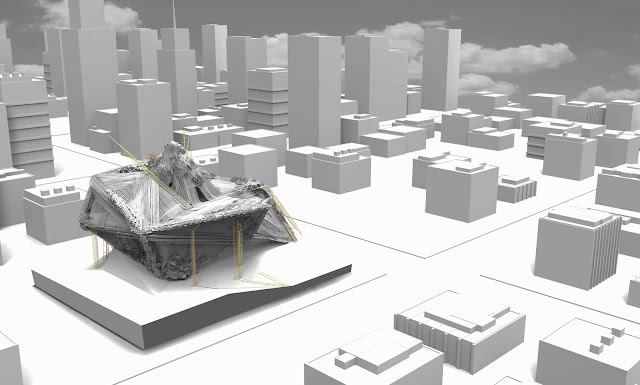Texas A&M University. Department of Architecture. T4T LAB Spring 2015.
ALIEN, MESSY, DISCRETE
Invited Professor: Gilles Retsin
With Gabriel Esquivel
Team: Michael Koernig, Ryan Samadh, Josh Berry, Michael Villareal, Jocelyn Zuniga.
When discussing the project it is important to draw the
distinction between representation and the limits of human perception and
understanding. In order to attempt to engage the object and attempt communication,
it is necessary for us as humans to assign some sort of construct that is
familiar to us. Whatever perceptions are drawn by humans it is inconsequential
to the object. This particular object It operates as an
autopoetic machine, one that is in a constant state of proliferation of its
parts, aggregating in various sizes and geometries, constantly expanding its
endo-structure in all directions. It fulfills this function of accumulation as
an autonomous object, defying human cognition or constructs.
In order to attempt to set up a discourse about the object,
we can quantify a scale of the “city” and that of the “house”. The house is one of the many parts that are
being perpetually proliferated by the city mass. It is only one part of an ever
increasing legion of aggregation, and yet within this one part of the machine,
we see it emerges as a machine within the machine in its own right and wiithin
the house through its own proliferation of parts. Each mereological system ,
the partition stones, the high-fi filaments of the slabs, or the fibers that
form into beams, is its own autonomous machine, whilst at the same time
creating a cohesive whole. These parts are not autonomous in the sense that
they are operating in defiance, or rebellion to being part of a whole. Rather,
their aggregation and expansion occurs without regard to what any other system
is doing. However, the villa is in truth just as alien, incomprehensible, and
in perpetual proliferation as the city itself is, functioning as its own
autonomous machine unto itself.
In the development of the project, two fundamentally
opposite ideas emerged as influences, those being elements found in Russian
constructivism, the other being the prairie style of house that was taking hold
in the west at the same time. These create conflict within the project not only
on an architectural level, but on a socio-political level as well, creating a
conflict of regimes within the project. In a sense, Marxist Russian
constructivism and the capitalist west can be viewed as hyper objects in their
own right, in the sense that they are also beyond the realm of human
limitations, and exist and operate in a realm beyond that of what can be
quantifiable. When these ideologies are brought together, they do possess some
overlap. Marxist Russia was all about unification, and the removal of
hierarchy. And while the dogma of capitalism is about fragmentation and the
individual, this is evident in the project, for as the project aggregates its
pieces in unification and fragmentation, there is not really a sense of
hierarchy of parts, at least by the limitations that we as humans can recognize
in the object.
Another fundamental tenant of Russian constructivism is the
idea of building up, from the ground up vertically. And when one thinks of
Capitalist architecture, the first thought that may come to mind is the classic
notion of the huge, vertical high rise. However, the “house” clearly is
celebrating horizontality, which we as humans can perceive as being Capitalist
in different terms, in terms of land expansion, of the single villas occupying
plots of land that was championed by Frank Lloyd Wright’s prairie style of
house, one that is a purely western phenomenon. At the scale of what we can
perceive as the “house,” capitalism celebrates the horizontal, the long
sweeping planes displayed in projects such as the Robie and Farnsworth Houses.
The conflict in regimes is not the only source of tension
the project is under. Internally, what we perceive as the house scale is under
a Lacanian sort of psychoanalytical tension, as it is negotiating the
relationship between interior and exterior. It is in need of “therapy”, unable
to come to terms with mixed conditions, is it and extroverted architecture by
means of the transparent exterior curtain wall is it about making it a condition of interior affects .
The project is in a sort of Wright vs. Mies conflict, not committing to one
over the other. (Is it about the interior or is it about the exterior or both? It is, as Deluze would say, in a state of
flux, and this creates confusion, tension within the inside mechanism of the
project. This psychoanalytical tension gives a beautiful fallacy of
accessibility. The tension of the project in how it expresses interaction of
interior or exterior is palpable, and yet within it there is still space within
that feels domestic,and comfortable. In actuality, this is of no concern to the
object, as it is wholly indifferent to how it may be perceived by the human
mind. But to us, to the viewer, this comfortability, this familiarity, is a way
for us to resolve the tension, to find forms of inhabitation to find resolution
to it, not in terms of the machine, for our desire of communication.

























